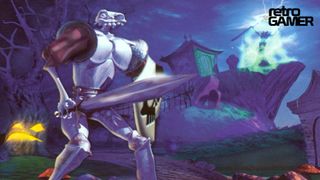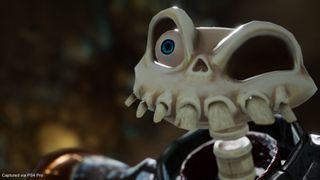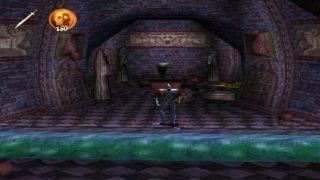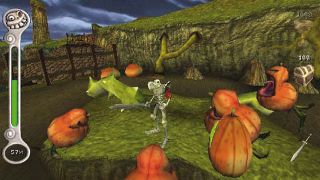The making of MediEvil – how a small team beat the odds to deliver PlayStation's answer to Banjo-Kazooie
With a stunning new PS4 remaster available, we decided to return to the original ghoulish classic to see how it was made

Video games are fundamentally about escapism. It's uninspiring then that the vast majority of video game heroes fall into archetypal stereotypes. Bearing this in mind, the choice of lead for the hugely enjoyable MediEvil series is an odd one to say the least; the undead Sid Daniel Fortesque is neither muscle-bound nor suitably heroic. In fact, he's a complete failure as a hero.
When he was alive, Fortesque was a liar and a charlatan. He attained a position of power and influence in the Kingdom of Gallowmere thanks to his tall tales and fabricated exploits. However, when the land was faced with genuine peril, Sir Dan found himself pushed to the frontline where he promptly perished in the opening seconds of battle. Gallowmere's armies nevertheless triumphed over the sinister Sorcerer Zarok, and, afraid that he would look a fool for giving such a coward high office, the King decided to venerate Fortesque as the saviour of the land. Years later, Zarok returns and unwittingly reanimates Sir Dan's decomposed corpse – giving the pathetic knight a second chance to redeem himself. Game on.

This feature first appeared in Retro Gamer. If you want in-depth features on classic games delivered straight to your door (or your inbox), then you should subscribe to Retro Gamer.
Chris Sorrell, previously famous for creating the loveable aquatic secret agent James Pond, is the brains behind the MediEvil concept and makes it clear that he wanted his game to possess a unique lead character from the outset. "We worked with a script doctor named Martin Pond, looking for more of a backstory for Dan," he says. "Martin made the brilliant leap that Sir Dan could have been a pompous failure in life whose reincarnation was his one shot at redemption." This distinctive plot – twinned with Sir Dan's unusual appearance – turned out to be quite appealing to some sectors of the gaming community, as lead designer Jason Wilson explains, "Oddly enough we heard after the game's release that a lot of women played MediEvil and they found Dan to be very endearing. I guess it was an antidote to all the macho video game characters. Apparently Dan was something of a sex symbol in France!"

"Fate smiled on us and we had our dream opportunity of building the game, from scratch, as a PlayStation exclusive"
Chris Sorrell
But the road to creating a video game sex symbol for our European cousins – not to mention one of the most enjoyable platform romps of the PlayStation era – was not an altogether smooth one. Prior to the development of Sir Dan's debut adventure, Sorrell had endured a rather torrid time on other projects. "I was asked to help out on some new edutainment products that Millennium had just signed up to create, based around Raymond Briggs' The Snowman and Father Christmas books," he remembers. "Once these products were finally complete I think management took pity on me and rewarded me with the chance of making my dream game. There were a few ideas I'd been bouncing around for a while and in particular two sources of inspiration that I felt we could combine in a unique way." And what exactly were those two inspirations? "Ghosts 'N Goblins was one and the other was a love for Tim Burton's art style, as typified in The Nightmare Before Christmas," he explains. "Logically this led to the concept of an undead knight, who was christened 'Dead Man Dan' in my first concept proposal."
Sorrell and Wilson's predilection for all things gothic helped to shape the unique theme of this fledgling project. "I was very lucky that from the earliest stages I was able to work with Jason," explains Sorrell, who has thankfully put his days of wearing black eyeliner behind him. "I guess there's no denying that we both had 'goth' tendencies and we were equally excited to create a game borrowing from such sources."
Big ambitions

Considering the humble studio size, MediEvil was an epic project. "Millennium was a small company with big ambitions. We needed publisher support to finance those ambitions," says Sorrell. "Consequently the first year of development was as much about creating materials to sell the game as it was building the design. Although we knew we wanted to make a console game, there was no certainty of which platform it would be on. For a while we thought we might be signing up with Sega – we even started work on the Saturn – but it wasn't until about ten months in when we met with Sony. Fate smiled on us and we had our dream opportunity of building the game, from scratch, as a PlayStation exclusive."
Sony's support certainly helped to ease the financial burden on the team, but making the transition from producing 2D games to 3D ones wasn't easy. "It was a huge challenge," reveals Sorrell. "None of us had built a full 3D game before. Of course, since so much was new, there was a really gratifying sense of achievement as things started to function. I remember the first time we saw the textured 3D world running in game… it was moments like that which really brought our team together." Wilson concurs,"We were constantly amazed when we got a 3D object on screen or a texture on a cube, it was like we were unravelling DNA or something."
Sign up to the GamesRadar+ Newsletter
Weekly digests, tales from the communities you love, and more
The fact that 3D gaming was really starting to come of age also helped the team. "During development Super Mario 64 arrived," remembers Sorrell. "We played an import copy and were blown away by how well it brought those familiar Mario mechanics into 3D. Tomb Raider was another game that couldn't help but make an impact, and then there was the first Crash Bandicoot game that set such an amazing visual standard. We were sufficiently under way that none of these games really changed our plan, but they certainly helped us to understand how we might solve some of the challenges we were facing in building a 3D action game for the first time."
Internal rumblings

Late in development Sony requested that MediEvil should support the (then) new PlayStation analogue controller, which turned out to be a particularly fortuitous event. "I was so glad when we were asked to include support for the new pad," comments Sorrell. "It was quite a way into development and we were certainly struggling to capture even a fraction of the fluidity and intuitiveness that Mario 64 was so effortlessly offering thanks to the N64 controller. Once our new prototype pad arrived, it was actually really simple to hook up a camera-relative control system and after a small amount of debate we decided to make both analogue and digital controls camera-relative, using a weighting system to allow this style of control via the eight directions of the D-pad."
As development progressed, internal rumblings at Millennium caused Sorrell and his team some rather sleepless nights. "We were working very closely with Sony," he explains, "at a time when the portion of the Millennium team that had developed Cyberlife – an AI technology that was first used in the PC title Creatures – was rather more concerned with developing that technology than in developing regular games. They were looking to sell the 'traditional' games division. We reached a point where it was looking quite possible that we might be sold to a company that many of us thought would be a really bad partner." Sorrell knew that it was necessary to act in order to try to safeguard his project. "I took a huge personal gamble and arranged a clandestine meeting with our Sony producer. I told him what was happening, and that I could imagine nothing better than if we could finish development of the game as a first-party Sony studio. Fortunately, a few months later we became Sony's second United Kingdom development studio."
MediEvil repaid Sony's faith several times over and was a massive success on both sides of the Atlantic when it was released in time for Halloween 1998. Sorrell is especially pleased with how it performed, "It was the best possible vindication of the enthusiasm and belief we'd long had in the project. It was especially exciting that SCEA were so behind the game, since this was an entirely European project with a very English sense of humour. For me, a real highlight was taking MediEvil to E3 in 1998 and seeing one of the official E3 shuttle buses emblazoned with characters from the game."
Sequel time

A sequel was inevitable, but sadly Sorrell wasn't as involved as he have would liked to have been. "I made a really stupid decision after MediEvil," he says. "I was given the opportunity to come up with a brand new game for the PlayStation 2 – which would become Primal – and I took it. I had a few new MediEvil ideas already scribbled down, but I moved onto creating the concept for this new PS2 project and James Shepherd took the helm on MediEvil 2." Even so, Wilson is full of praise for Sorrell's influence on the second game. "Chris came up with the marvellous idea of setting the game in the Victorian era with all the characters of Victorian literature," he explains. "But he ended up working on Primal, so I just ran with the idea with a new team which was fun, but I took more of a back seat in terms of design." Although he wasn't as involved as he would have liked to have been Sorrell is nevertheless pleased with what was achieved with MediEvil 2, "All told, I think they did a nice job with the sequel and I was certainly pleased to see it meet with further success in the market."
Bizarrely, the franchise bypassed the PS2 altogether. "Although the second one did well, it didn't scream 'must make a sequel' to the management," recalls Sorrell. "James Shepherd had the opportunity to create his own game and quite understandably took it – this became Ghosthunter. Since we were only a two-project studio, Dan's main PS2 opportunity had passed. Later in the PS2's lifetime I actually pitched a MediEvil 3 concept, but sadly it wasn't to be."
"I've worked on many games, but none of them have a place in my heart like MediEvil"
Jason Wilson
The next (and last, until MediEvil was brought to life for PS4 earlier this year) outing for Sir Daniel would be the PSP remake MediEvil: Resurrection, released in time for the portable console's launch in 2005. "By this time our studio management had changed, and although I stressed how much I would have loved to work on bringing MediEvil up to date, the boss wanted me to work on another project instead," laments Sorrell. "Given my interests and strengths I think that was a really dumb move. Don't get me wrong, there were some very talented people working on MediEvil PSP and they did an awesome job, especially considering the time constraints they were up against. But I was really sorry to see certain characters needlessly redesigned and frustratingly powerless to stop it." Wilson's involvement was slightly more significant – he supplied Dan's voice – but he too was disheartened with having to watch something he dearly loved get needlessly tinkered with, "It was a strange feeling to see something you loved being remade by others. I now know what all those directors feel like when their movies are remade."
Sorrell and Wilson have gone on to enjoy successful careers since MediEvil, but both confirm that they harbour a special affection for the exploits of the hapless Sir Dan. "I've worked on many games, but none of them have a place in my heart like MediEvil… it's gratifying that it is considered a classic," says Wilson. "Nothing I've worked on since has come close to offering the creative freedom and 'anything goes' spirit that characterised MediEvil's development," Sorrell adds. "We were a young, largely inexperienced team that bonded behind a desire to make the most fun, charismatic game we could. All told, I think the spirit and appeal of MediEvil is a reflection of the crazy experiences and sheer fun we had making it. It's a sad fact that games just don't tend to be made like that any more."
This feature first appeared in Retro Gamer magazine issue 49. For more excellent features, like the one you've just read, don't forget to subscribe to the print or digital edition at MyFavouriteMagazines.

Oh, that's why the Stellar Blade devs were terrified by demo players: one fan's spent "about 60 hours" maxing Eve's skill tree before the action RPG is even out

A new Taylor Swift song mentions GTA, but some remember it mentioning Baldur's Gate 3, Final Fantasy 14, and more in hilarious Twitter trend
Most Popular




